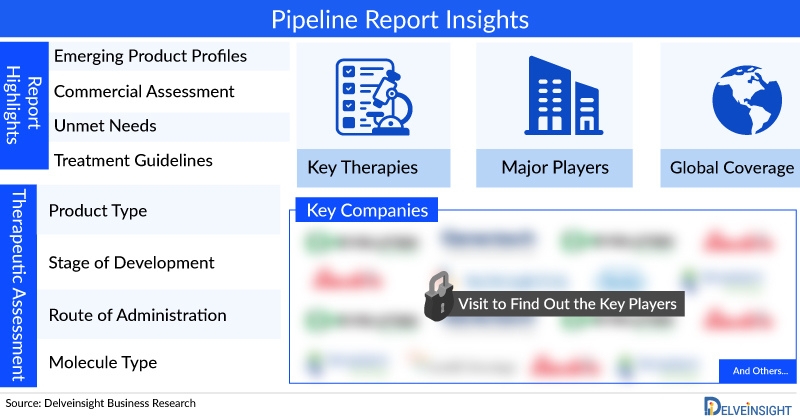DelveInsight’s “Mineral Metabolism Disorder – Pipeline Insight, 2025” showcases a diverse range of candidates addressing conditions such as hypoparathyroidism, hyperphosphatemia, Wilson’s disease, and iron overload syndromes. Mid- and late-stage programs include synthetic and recombinant parathyroid hormone analogs, calcimimetics, and next-generation phosphate binders designed for enhanced bioavailability and patient adherence. Investigational biologics targeting fibroblast growth factor 23 (FGF23) pathways, as well as novel iron chelators with improved safety profiles, are advancing in clinical evaluation. Innovative drug delivery systems—such as controlled-release oral formulations and subcutaneous implants—are also being developed to optimize pharmacokinetics and patient convenience.
The 2025 pipeline signals a shift toward disease-modifying approaches, leveraging advancements in endocrinology, hepatology, and renal medicine. Increasing regulatory focus on rare metabolic disorders, combined with growing awareness of the systemic burden of mineral dysregulation, is driving investment and cross-disciplinary research. With targeted hormonal therapies, refined chelation agents, and pathway-specific biologics progressing toward commercialization, the next generation of treatments could redefine outcomes for patients with mineral metabolism disorders.
Interested in learning more about the current treatment landscape and the key drivers shaping the Mineral Metabolism Disorder pipeline? Click here
Key Takeaways from the Mineral Metabolism Disorder Pipeline Report
• DelveInsight’s mineral metabolism disorder pipeline analysis depicts a strong space with 5+ active players working to develop 5+ pipeline drugs for mineral metabolism disorder treatment.
• The leading mineral metabolism disorder companies include Medtronic, Eli Lilly, Sanifit, Sanofi, and others are evaluating their lead assets to improve the mineral metabolism disorder treatment landscape.
• Key mineral metabolism disorder pipeline therapies in various stages of development include SOM0208, IB1001, Trappsol Cyclo, VTS-270, Arimoclomol, Hydroxypropyl-beta-cyclodextrin, and others.
• In July 2025, Entera Bio announced FDA agreement to use total-hip BMD as the primary endpoint for its Phase 3 oral PTH (EB613) osteoporosis program, streamlining registrational design.
• In March 2025, 52-week outcomes from the PaTHway study of palopegteriparatide were published, supporting sustained biochemical control and reduced supplement use.
• In August 2024, the FDA approved palopegteriparatide (Yorvipath; TransCon PTH) as the first hormone-replacement therapy for chronic hypoparathyroidism in adults—a landmark for mineral metabolism disorders.
Mineral Metabolism Disorder Overview
Mineral metabolism disorders refer to a group of medical conditions that disrupt the balance of essential minerals in the body, such as calcium, phosphorus, magnesium, and potassium. These imbalances can lead to various health issues, including bone deformities, cardiovascular complications, and neurological symptoms. Common causes include chronic kidney disease (CKD), hormonal imbalances (such as parathyroid disorders), genetic mutations, and inadequate dietary intake or absorption. Among these, disorders like hyperphosphatemia, hypocalcemia, and disturbances in vitamin D metabolism are frequently associated with CKD-related mineral and bone disorders (CKD-MBD).
Management typically involves addressing the underlying cause while maintaining optimal mineral balance through dietary interventions, phosphate binders, vitamin D analogs, or hormone replacement therapies. Recent advances in therapeutics focus on targeting fibroblast growth factor 23 (FGF23) and parathyroid hormone (PTH) pathways to better regulate mineral homeostasis. Accurate diagnosis and timely treatment are crucial to prevent long-term complications such as vascular calcification and bone fractures.
Find out more about mineral metabolism disorder medication at https://www.delveinsight.com/report-store/mineral-metabolism-disorder-pipeline-insight
Mineral Metabolism Disorder Treatment Analysis: Drug Profile
Hexasodium Phytate: Sanifit
Hexasodium phytate (SNF472), developed by Sanifit, is a selective inhibitor of calcification that works by binding to the growth sites of hydroxyapatite (HAP) crystals—the primary component of ectopic calcification deposits. This mechanism helps prevent the formation and progression of abnormal calcifications. SNF472 has received orphan drug designation from both the FDA and EMA for its potential use in treating calciphylaxis.
Learn more about the novel and emerging mineral metabolism disorder pipeline therapies.
Mineral Metabolism Disorder Therapeutics Assessment
By Product Type
• Mono
• Combination
• Mono/Combination.
By Stage
• Late-stage products (Phase III)
• Mid-stage products (Phase II)
• Early-stage product (Phase I) along with the details of
• Pre-clinical and Discovery stage candidates
• Discontinued & Inactive candidates
By Route of Administration
• Oral
• Parenteral
• intravitreal
• Subretinal
• Topical
By Molecule Type
• Monoclonal Antibody
• Peptides
• Polymer
• Small molecule
• Gene therapy
Scope of the Mineral Metabolism Disorder Pipeline Report
• Coverage: Global
• Key Mineral Metabolism Disorder Companies: Medtronic, Eli Lilly, Sanifit, Sanofi, and others.
• Key Mineral Metabolism Disorder Pipeline Therapies: SOM0208, IB1001, Trappsol Cyclo, VTS-270, Arimoclomol, Hydroxypropyl-beta-cyclodextrin, and others.
Explore detailed insights on drugs used in the treatment of mineral metabolism disorders here.
Table of Contents
1. Introduction
2. Executive Summary
3. Mineral Metabolism Disorder Pipeline: Overview
4. Analytical Perspective In-depth Commercial Assessment
5. Mineral Metabolism Disorder Pipeline Therapeutics
6. Mineral Metabolism Disorder Pipeline: Late-Stage Products (Phase III)
7. Mineral Metabolism Disorder Pipeline: Mid-Stage Products (Phase II)
8. Mineral Metabolism Disorder Pipeline: Early Stage Products (Phase I)
9. Therapeutic Assessment
10. Inactive Products
11. Company-University Collaborations (Licensing/Partnering) Analysis
12. Key Companies
13. Key Products
14. Unmet Needs
15. Market Drivers and Barriers
16. Future Perspectives and Conclusion
17. Analyst Views
18. Appendix
About DelveInsight
DelveInsight is a leading Business Consultant and Market Research firm focused exclusively on life sciences. It supports Pharma companies by providing comprehensive end-to-end solutions to improve their performance. Get hassle-free access to all the healthcare and pharma market research reports through our subscription-based platform, PharmDelve.
Media Contact
Company Name: DelveInsight
Contact Person: Jatin Vimal
Email: Send Email
Phone: +14699457679
Address:304 S. Jones Blvd #2432
City: Las Vegas
State: Nevada
Country: United States
Website: https://www.delveinsight.com/

